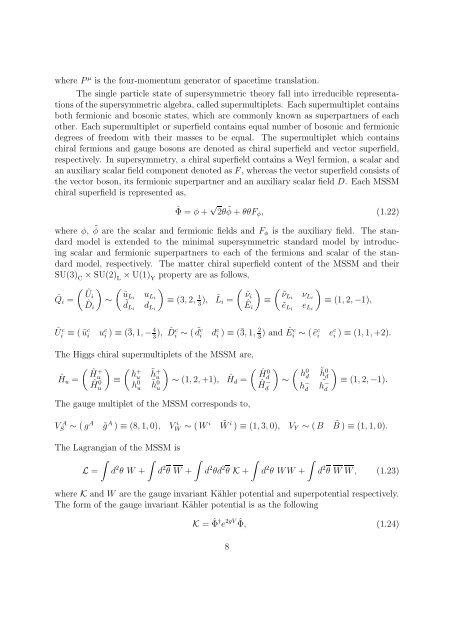PHYS08200604017 Manimala Mitra - Homi Bhabha National Institute
PHYS08200604017 Manimala Mitra - Homi Bhabha National Institute
PHYS08200604017 Manimala Mitra - Homi Bhabha National Institute
You also want an ePaper? Increase the reach of your titles
YUMPU automatically turns print PDFs into web optimized ePapers that Google loves.
where P µ is the four-momentum generator of spacetime translation.<br />
The single particle state of supersymmetric theory fall into irreducible representations<br />
ofthe supersymmetric algebra, called supermultiplets. Each supermultiplet contains<br />
both fermionic and bosonic states, which are commonly known as superpartners of each<br />
other. Each supermultiplet or superfield contains equal number of bosonic and fermionic<br />
degrees of freedom with their masses to be equal. The supermultiplet which contains<br />
chiral fermions and gauge bosons are denoted as chiral superfield and vector superfield,<br />
respectively. In supersymmetry, a chiral superfield contains a Weyl fermion, a scalar and<br />
an auxiliary scalar field component denoted as F, whereas the vector superfield consists of<br />
the vector boson, its fermionic superpartner and an auxiliary scalar field D. Each MSSM<br />
chiral superfield is represented as,<br />
ˆΦ = φ+ √ 2θ˜φ+θθF φ , (1.22)<br />
where φ, ˜φ are the scalar and fermionic fields and Fφ is the auxiliary field. The standard<br />
model is extended to the minimal supersymmetric standard model by introducing<br />
scalar and fermionic superpartners to each of the fermions and scalar of the standard<br />
model, respectively. The matter chiral superfield content of the MSSM and their<br />
SU(3) C<br />
×SU(2) L<br />
×U(1) Y<br />
property are as follows,<br />
) (Ûi<br />
(ũLi ˆQ i = ∼ ˆD i<br />
u Li<br />
˜d Li d Li<br />
)<br />
≡ (3,2, 1 3 ), ˆLi =<br />
( ) )<br />
ˆνi<br />
(˜νLi ν<br />
≡<br />
Li<br />
≡ (1,2,−1),<br />
Ê i ẽ Li e Li<br />
Û c i ≡ (ũ c i u c i ) ≡ (¯3,1,− 4 3 ), ˆDc i ∼ ( ˜d c i d c i ) ≡ (¯3,1, 2 3 ) and Êc i ∼ (ẽc i e c i ) ≡ (1,1,+2).<br />
The Higgs chiral supermultiplets of the MSSM are,<br />
) )<br />
Ĥ u =<br />
(Ĥ+<br />
u<br />
Ĥ 0 u<br />
(<br />
h<br />
+<br />
≡ u<br />
˜h+ u<br />
h 0 u<br />
˜h 0 u<br />
∼ (1,2,+1), Ĥ d =<br />
(<br />
Ĥ0 d<br />
Ĥ − d<br />
The gauge multiplet of the MSSM corresponds to,<br />
) ( ) h<br />
0<br />
∼ d<br />
˜h0 d<br />
h − ˜<br />
d<br />
h − ≡ (1,2,−1).<br />
d<br />
V A<br />
S ∼ (gA ˜g A ) ≡ (8,1,0), V i W ∼ (Wi ˜Wi ) ≡ (1,3,0), V Y ∼ (B ˜B) ≡ (1,1,0).<br />
The Lagrangian of the MSSM is<br />
∫ ∫ ∫<br />
L = d 2 θ W + d 2 θ W +<br />
∫<br />
d 2 θd 2 θ K+<br />
∫<br />
d 2 θ WW +<br />
d 2 θ W W, (1.23)<br />
where K and W are the gauge invariant Kähler potential and superpotential respectively.<br />
The form of the gauge invariant Kähler potential is as the following<br />
K = ˆΦ † e 2gV ˆΦ, (1.24)<br />
8
















